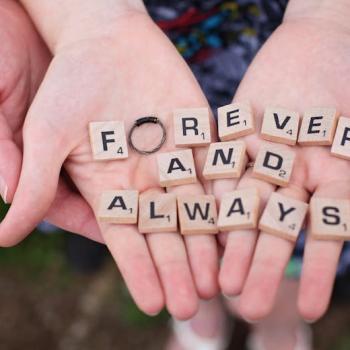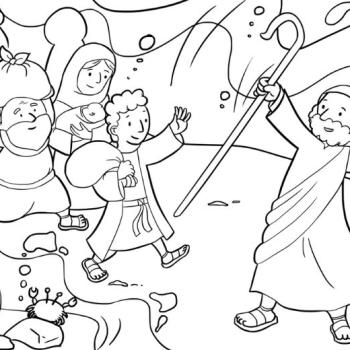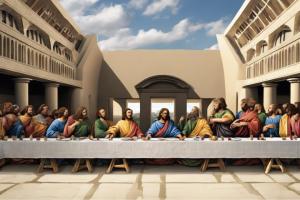
The 2024 Paris Olympics wrapped up on Sunday. But its opening ceremony will forever be way more memorable than the closing one because of a controversial Last Supper tableau that caused quite a stir among Christians worldwide, especially on my Facebook feed.
Reminiscent of Leonardo da Vinci’s painting, The Last Supper, this tableau raised eyebrows and prompted discussions about religious symbolism and respect. The public reaction to this event sparked a passionate and divided debate, highlighting the need for an extra measure of interpersonal grace.
In this post, I’ll describe the event in detail, as well as the related criticisms and defenses. I’ll discuss some of the more personal reactions from my friends on Facebook, and I will look at how the Bible suggests we should react to such situations, both now and in the future.
What Happened at the Controversial Ceremony
At the opening ceremony tableau, drag queens and dancers lined up along a long table. A dinner platter lifted to reveal a mainly nude and blue Philippe Katerine singing in French.
Before all this, though, the camera focused on a woman (DJ Barbara Butch), crowned with an aureole and sitting in front of turntables. Then, it panned out to the rest of the performers, all in different poses at the table. The table then transformed into a catwalk as the drag queens and models took the stage, paying homage to Paris’ fashion scene.
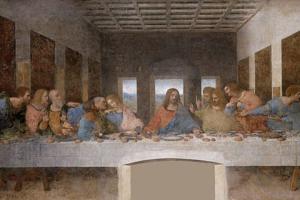
Similarities to The Last Supper
Some viewers connected the tableau to Leonardo da Vinci’s The Last Supper, which depicts Jesus Christ and His 12 disciples sharing a final meal before His crucifixion. The drag queens were posed in near-perfect alignment with the 12 figures at the dinner table in da Vinci’s painting, with their positions, angles of heads and outstretched arms almost identical to the iconic artwork. In some instances, the poses were mirror images of the poses of the figures in the painting.
Immediate reactions
The scene sparked outrage from religious conservatives, politicians, and Catholic church leaders, who believed it was a mockery of the Last Supper. Figures such as Roman Catholic Bishop Robert Barron condemned the scene on social media, while French Catholic bishops complained about the “mocking” of Christianity. Some Greek Orthodox Church representatives also denounced the opening as “blasphemous.”
However, the ceremony’s artistic director, Thomas Jolly, clarified that the tableau was not inspired by The
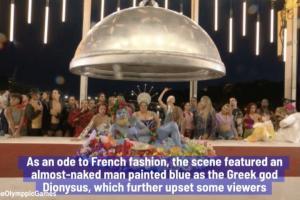
Last Supper. On the contrary, it represented the Greek god Dionysus arriving at a celebration the gods of Olympus were throwing. Jolly stated he did not intend to be “subversive,” or to “mock,” or “shock.” He said he was trying to convey France’s values of freedom and inclusion.
Organizers’ Explanation and Apology
Jolly further insisted the tableau was not a reference to The Last Supper. Instead, it was a nod to a pagan celebration featuring Dionysus. Jolly explained, “The idea was to create a big pagan party in line with the god of Mount Olympus. My wish isn’t to be subversive, nor to mock or to shock. Most of all, I wanted to send a message of love, a message of inclusion and not at all to divide.”
Jolly told BFMTV, “You will never find in me, or in my work, a desire to mock or denigrate anyone. My aim was to create a ceremony that heals and reconciles, but also a ceremony that reaffirms the values which are those of our Republic of Liberty, Equality, Fraternity, and absolutely not to mock anyone.”
Official apology from the Olympic Committee
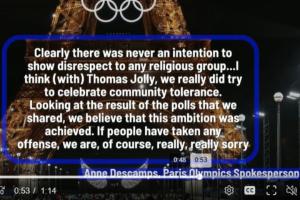
In an official statement, the International Olympic Committee emphasized the importance of engaging with cultural narratives in a manner that fosters understanding rather than perpetuating stereotypes or offending communities. This acknowledgment serves as a reminder of the need for sensitively balancing the needs of individuals during an international event, as well as the need to engage in ongoing dialogue concerning the implications of artistic choices within a multicultural context.
While the actual wording of the apology sounds suspiciously like a non-apology – “We’re sorry you were offended,” not “We’re sorry we made an offensive choice” – it appears that the committee is willing to learn from this incident to make more thoughtful and respectful representation decisions for future ceremonies.
Christian Perspectives and Concerns
Many Christians interpreted the tableau as a mockery of Leonardo da Vinci’s iconic painting. Art historian Sasha Grishin noted the resemblance, stating:
“The idea of the central figure with a halo and a group of followers on either side — it’s so typical of The Last Supper iconography that to read it in any other way might be a little foolhardy.”
Grishin further explained that the central figure’s headdress resembled the halos used in High Renaissance-style Last Supper paintings to depict Jesus, while the drag queens’ poses mirrored those of the disciples. He emphasized that the scene represented a “very, very sacred image” to Christians, symbolizing Jesus’ willingness to sacrifice Himself for humanity’s sins.
Conservative political figures like House Speaker Mike Johnson (R-La.) condemned the performance as “shocking and insulting to Christian people around the world.” Some businesses, like the U.S. telecommunications provider C Spire, pulled their advertising from the Olympics broadcasts in response to the controversial scene. Even social media influencer Andrew Tate, who is currently facing trial in Romania on human trafficking and rape charges, criticized the Olympics for mocking Christianity and called on athletes to boycott the event.
Trial by Facebook
Many of my Christian friends started sharing outraged comments and inflammatory memes hours after the opening ceremony took place. The discussions lasted for days, and, as many Facebook discussions do, some of them turned rather heated.
However, some people argued that the outrage stemmed from a misunderstanding, as the tableau was intended to depict the ancient Greek god Dionysus and the Feast of Dionysus, rather than a direct reference to the Last Supper. They suggested that the parallels drawn by Christians were due to the shared symbolism and iconography between Greek mythology and Christianity.
What Christians Should Take Away from the Controversy
Conclusion
Moving forward, this controversy might lead to more thoughtful considerations about the use of religious imagery in secular contexts, aiming to foster understanding and respect across different beliefs and perspectives.
FAQs
1. What is the controversy surrounding the Last Supper tableau at the 2024 Olympics?
The controversy stems from a performance that Catholic leaders in France have criticized as a “mockery of Christianity.” The Conference of French bishops expressed deep regret over the depiction, which they viewed as derisive and mocking towards Christian beliefs.
2. Why has the Olympics’ depiction of the Last Supper been criticized?
Critics argue that the Olympics’ show, directed by Thomas Jolly, included elements that mocked Leonardo da Vinci’s famous painting, “The Last Supper,” which portrays Jesus Christ and his apostles. Despite Jolly’s claims of not being inspired by the original artwork, the portrayal, particularly the inclusion of Butch and drag queens, was seen as disrespectful.
3. What specific aspect of the Olympics’ Last Supper tableau was considered mockery?
The tableau involved a performer breaking into song while drag queens danced behind him, which many viewed as a parody of “The Last Supper.” This New Testament scene, famously depicted by Leonardo da Vinci, was interpreted by some as being ridiculed in the performance.
4. What are other controversies associated with the 2024 Olympics?
The 2024 Summer Olympics faces several other issues including security concerns, human rights debates, and controversies over the participation of Israel during the Israel-Hamas conflict, and the inclusion of Russian and Belarusian athletes as neutrals during the ongoing Russian invasion of Ukraine.




